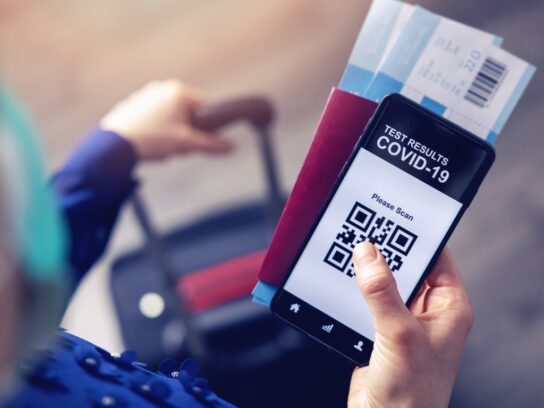
Toulmin’s Travel Theorem
I want to travel again. I’ve been sitting on my couch for 18 months and have watched every decent and half-decent Netflix and Amazon show – twice! Specifically, I want to travel to England to search for the missing Banqueting Hall of Queen Elizabeth I – a subject for another column.
Given Covid and the Delta variant, should I go? Should you go on a similar trip?
That depends on your risk assessment. As a statistician and economist, I know that all activities have risks. By sitting at home on my keister for 18 months, and only going out occasionally for grocery shopping while wearing a KN95 mask, my risk of getting Covid has been tiny, but my risk of heart disease has gone up. By getting double Pfizer vaccinated for Covid, I quickly reduced my serious disease risk by about 95%, while my risk of having serious complications from the shots was only about 11 in 5,000,000 (StatNews 9/7/2021) – astoundingly low, and thus making the shots very worthwhile. (I’ll bet you that every top poker player in the world has figured those odds and is now fully vaccinated!)
So how do I assess the risk of traveling to England? My wife refuses to go, as she quite sensibly fears Covid and Delta. Is she right? Well, let’s see if we can do some calculations to solve what I will call Toulmin’s Travel Theorem. This says: I will travel if the Covid risk per day is probably about the same as (or lower than) the risk per day of me having a serious accident here in the U.S. Of course such a risk is pretty darn low.
The American Association for the Surgery of Trauma (AAST) states (AAST “Trauma Facts” 2021) that “in the US, injury accounts for 150,000 deaths and over 3,000,000 non-fatal injuries per year.” Taking these 3,150,000 events per year divided into the U.S. population of 330,000,000 times 365 days per year yields the daily chance of traumatic death or serious injury in the U.S. for an individual. That figure is 1 in 38,238 (risk of an event per day). This calculation does not include disease, only causes such as auto crashes, gun violence, suicide, overdose, home accidents, and other traumas. Surprisingly, the worst threat is “poisoning by noxious substance” (not drug overdose or car crash), with an amazing 62,339 deaths in 2018 (per the Insurance Information Institute, “Mortality Risk”).
How about the risk of travel? First of all, The New York Times (9/7/2021) estimates that the current chances of “an average vaccinated American contracting Covid are probably about 1 in 5,000 per day, and even lower for people who take precautions or live in a highly vaccinated community.” This is based on their analysis of detailed data on vaccinated people in Utah, Virginia and some metro areas. And the NYT estimates that in places with fewer cases the daily chances are “only 1 in 10,000.” We can use these two states as proxy benchmarks in our calculations.
Second, examining current September data from the well-regarded University of Washington IHME (Institute for Health Metrics and Evaluation; covid19.healthdata.org) Covid database, we can see that Utah currently has about 103 new Covid infections per day per 100,000 population, while Virginia has about 110 – close to the U.S. national average of 112 per 100,000, or 1 in 893. Of course, these figures are for all people in each state, including unvaccinated people, who represent almost all new infections and deaths; and these states do not have high usage of masks or social distancing (per the IHME charts). So in those two states, with about U.S.-average risk for all people, IF YOU GET FULLY VACCINATED, your risk drops to about 1 in 5,000 per day (per NYT).
Third, we can now examine IHME’s projections for when I want to travel to England – mid-October 2021. IHME predicts the end of October rates thereof 125 per 100,000, about 17% higher than in our proxy benchmark states of Virginia and Utah. (Note that IHME calculates that if all English people would just wear masks, this rate would drop to 14 per 100,000, about 9 times lower!) Thus we can estimate that my fully vaccinated risk per day rate of 1 in 5,000 will drop by about 17%, to 1 in 4,150 by going to England instead of Utah or Virginia. This is substantially worse than my target risk rate of 1 in 38,238. Uh, oh. BUT, consider the following.
Fourth, I reduced my risk by getting a third (“booster”) shot; this likely improved my odds by about 20% (I guesstimate that my Pfizer protection from my March shots had faded from 95% to 75% effective, and is now back up to 95+%, thus about 20+% better). Hence I am back up to 1 in 5,000 or better. (Yes, I felt a bit guilty that my third shot was not being used in Vanuatu or Kiribati, two of my favorite developing countries, but I saw no evidence that my Walgreens was about to ship that close-to-expiration shot to my buddies overseas.)
Fifth, I plan to wear N95, KN95 or 99% particulate masks on the plane and while in museums, shops, and any other in-door settings in England. I will eat outside or get carryout, rent a car, and avoid public transport wherever possible. I will avoid my beloved but crowded London (darn!) and focus on outdoor rural areas – including the village of Winchcombe in the Cotswolds, where our team thinks the missing Banqueting Hall is. I won’t go to parties or sporting events. All this should improve my odds dramatically, by 20-fold or more (an N95 mask filters all but 5 of 100 particles, so that is a 20-times improvement). Yippee! I have achieved a rate of about 1 in 100,000! (5,000 x 20 = 100,000.) This is much better than my target of 1 in 38,238.
To recap in plain English: by being fully (and now triply) vaccinated, wearing a high-quality mask, physically distancing, avoiding crowds and taking other sensible measures, there is less chance that I will get Covid in England than there is of me having a serious accident here in Montgomery County.
And of course, if I DO get Covid in England, my chance of death (since I am vaccinated) is only about 0.7% (per Massachusetts data, NBC Boston, 9/8/2021) and my “long Covid” risk is reduced at least by half (Healthline and The Lancet, 9/1/2021) – or to about 1 in 200,000.
Of course, with my luck, I will get hit by a bus in England!
Naturally, ALL of the above calculations are based on me (and you) being fully vaccinated. If you haven’t been vaccinated, you’re toast.
Photos courtesy Lew Toulmin
- History of the actual entire Covid pandemic and forecasts in England, for infections per 100,000 people, from the IHME of the University of Washington. The alarming red line forecast for October and out through December 1, 2021 is a “worst case” scenario; the purple (center) “current projection” line was used in the calculations described in this article; the optimistic but unrealistic green line is IHME’s forecast if all English people would wear masks.
- IHME chart for England, showing that observed mask usage peaked at 67% in February 2021, has declined to 29% recently, and is forecast to remain at that low, disappointing rate.
- IHME chart for Maryland, showing mask usage peaked in February 2021 at 85%, dipped in July to 29%, and rose recently to 46% — all compared to a target of 95%. IHME charts for each country on Earth and for all US states show these data, and also cumulative deaths, daily deaths, vaccine takeup, hospital resource use, daily infections and testing, and social (physical) distancing – all both actuals and forecasts for several months. The Maryland projections show that the state would save about 874 lives from September through December 1 if all Marylanders would wear masks. See: https://covid19.healthdata.org/united-states-of-america/maryland for the Maryland page. Use the three little lines in the upper right of each chart to change the chart settings, such as “actual numbers” vs. “numbers per 100,000 population.”







Comments are closed.